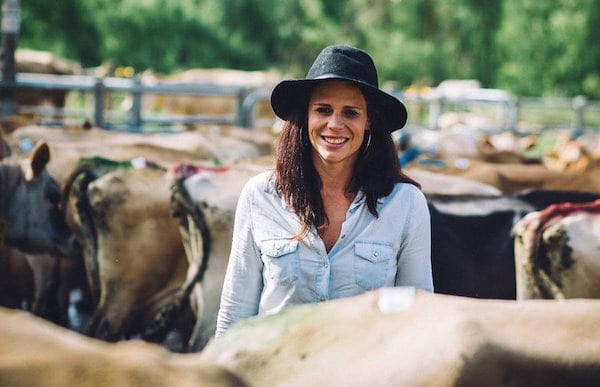Never before have farmers experienced such harsh, devastating conditions – with many farmers feeling as though they have no choice but to sell off their stock and leave their multi-generational properties. Others are waiting to assess the damage and are pleading with the Federal Government to not only support them throughout the bushfire recovery, but throughout the ongoing drought.
Jane Lindhe speaks with two women in farming on the challenges ahead.
On the front line
Sallie Jones, co-founder of Gippsland Jersey, says while farmers are fatigued and stressed by the events of the past fortnight, the bushfires have brought out the “best display of compassion and human kindness” she’s ever seen.
Sallie, who is also the founder of Warragul Farmers Market, has been involved with numerous community campaigns, including farmers’ mental health after losing her father to suicide four years ago. She says the strain on mental health will be the biggest challenge for farmers going forward.
“We convinced a number of farmers to tell their stories around mental health for a calendar last year,” she says. “Sadly some of those people have lost their farms during the fires…but they do know now that they can talk and share their stories.”
Sallie spent two highly stressful nights camped out in her dairy factory during the worst of the fires. While she didn’t directly lose stock, the completion of Gippsland Jersey’s new factory has been set back months due to the fires and her café business in East Gippsland has been “bleeding money” with no tourists visiting the town.
It was only during the bushfires that Sallie, like many people impacted by the fires, checked the fine print of her insurance policy. She quickly discovered her cows were not covered if they were killed in the fire, adding to her anxiety. Other neighbours had similar experiences, but lost everything. The only positive has been the support from the community, with offers of everything from feed for livestock to practical help on properties.
“I believe that 90 per cent of people can deal with an emergency during a disaster,” Sallie says. “It’s after that, when everyone moves back into neutral that mental health issues start happening. We need continued support and to keep people talking.”
While it is too early to assess the full breadth of the disaster, Sallie believes the recovery can be a positive way to bring people together. For example, when the region’s New Year’s Eve celebrations were cancelled, she opened her property and factory up for an alternative place for surrounding towns to celebrate.
“We need people to start visiting our regions again. We need strong political leadership and real collaboration with the affected communities,” she says.
Market analyst company Mercardo found that about 8.6 million head of sheep and 2.3 million cattle live in areas impacted by the bushfires in Victoria and New South Wales. Those numbers comprise around 12 per cent of the sheep flock and 9 per cent of the cattle heard in the regions, it found. But the true extent of how many have been killed or impacted will not be known for months.
National Farmers’ Federation President Fiona Simson describes farming as an industry on “the brink”. And the damage caused by the bushfires is not limited to the fire zone, she says.
“The fires will increase demand for already scarce fodder resources for drought-affected farmers and it is important that [the] Government’s response is coordinated across both the drought and the fires,” she said.
The NFF has been liaising closely with state and federal governments over agricultural fire relief and wants to ensure that the support goes beyond the immediate need for recovery assistance. It points to a recent report published by the Bureau of Meteorology that confirms that 2019 was the driest and hottest year on record for Australia, and those conditions are set to continue.
While Fiona describes farmers as “tough”, the huge challenges they face will be impossible to overcome without the co-ordinated support of governments, big business and the community. Government needs to support farmers to get back on their feet, she says.
“It’s a situation that grows graver each day, and shows no signs of abating,” she says. “We need an unprecedented response from government to help famers manage these unprecedented conditions.”
Despite the challenges, the NFF believes the agriculture industry could experience a turnaround over the next decade. But to achieve that, the right support and investments need to be made to capture the industry’s growth potential, it argues.
Agricultural support services
Victoria
- State recovery assistance services
- Fodder requests and donations: Victorian Farmers Federation, 1300 882 833
Stock loss and assessment: Agriculture Victoria, 1800 226 226
New South Wales
- State recovery assistance services
Disaster recovery grants
Fodder and water stock: Local Land Services and NSW DPI, 1800 814 647
Stock loss and assessment: Local Land Services and NSW DPI, 1800 814 647
Animal facilities for relocated livestock
South Australia
- State recovery assistance services
- Fodder requests and donations: Livestock SA, 0419 035 459
- Stock loss and assessment: PIRSA, 1800 255 556
Pictured above: Sallie Jones of Gippsland Jersey, Jindivick, 2016, Source: Museums Victoria, Photographer: Catherine Forge


